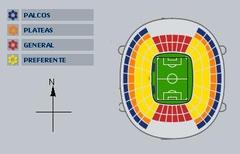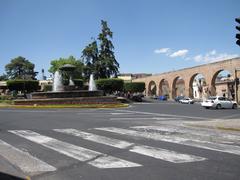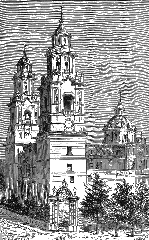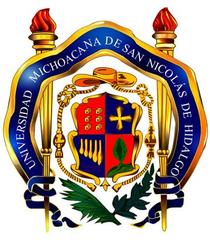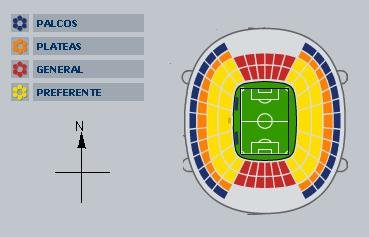
Morelos Stadium Morelia: Visiting Hours, Tickets, and Travel Guide
Date: 15/06/2025
Introduction
Estadio Generalísimo José María Morelos y Pavón—widely known as Estadio Morelos—is a landmark in Morelia, Michoacán, celebrated for its sporting legacy, striking architecture, and pivotal role in the city’s cultural life. Since its inauguration in 1989, the stadium has been the home of Atlético Morelia, hosting top-flight football, major concerts, and significant community events. Its location, historical resonance, and modern facilities make it a centerpiece for both local pride and visitor exploration (Atlético Morelia Official Site, Morelia Tourism Office, Football Tripper).
This comprehensive guide details everything you need to know: visiting hours, ticket purchasing, transportation, accessibility, nearby attractions, and practical tips for a seamless and memorable visit.
Table of Contents
- Introduction
- History and Cultural Significance
- Stadium Architecture and Facilities
- Major Events and Community Role
- Visitor Information: Hours, Tickets, and Entry
- Getting There and Accessibility
- Food, Amenities, and Safety
- Exploring Nearby Morelia
- FAQs
- Conclusion
- References
History and Cultural Significance
Estadio Morelos was constructed in response to Morelia’s growing sporting ambitions, replacing the older Estadio Venustiano Carranza. Although initially left out of the 1986 FIFA World Cup due to soil instability, the project was revived, and the stadium opened in April 1989 with a Liga MX match between Monarcas Morelia and Club América.
Named after José María Morelos y Pavón, a hero of Mexico’s War of Independence and a native of the region, the stadium serves as a monument to local and national identity. Over the years, it has expanded its purpose, becoming a venue for religious gatherings—such as Pope Francis’s 2016 visit—large-scale concerts, and charitable initiatives, cementing its place as a hub of Morelia’s social and cultural life (Contramuro, Wikipedia).
Stadium Architecture and Facilities
Design and Capacity
Estadio Morelos stands out for its irregular, asymmetrical design. Its “cabeceras” (ends) feature a single tier with 32 rows, while the sides (“laterales”) boast four levels, including general, premium, and VIP boxes, totaling 49 rows. The current official capacity is approximately 38,869, making it the eighth-largest stadium in Mexico and the largest in a city with fewer than one million residents (Football Tripper, Wikipedia).
Facilities and Upgrades
Key features include:
- Multiple VIP boxes and premium seating
- Modern locker rooms and medical facilities
- Ample parking (approx. 4,000 spaces)
- Electronic turnstiles and surveillance cameras
- Accessible seating, ramps, and restrooms
- Concession areas with local cuisine
- Merchandise stalls for official team gear
Technological improvements over the years include high-definition screens, advanced lighting for night matches, and enhanced security measures (StadiumDB).
Major Events and Community Role
Sporting Milestones
Estadio Morelos is the home of Club Atlético Morelia, hosting regular Liga de Expansión MX matches and playoff fixtures. The stadium has also welcomed international events, such as the 2011 FIFA U-17 World Cup and a friendly between Mexico and Bulgaria in 2001.
Cultural and Social Gatherings
Beyond football, the stadium is a preferred venue for concerts by artists like Chayanne, Luis Miguel, and Grupo Firme, drawing crowds of up to 55,000. It also supports community events and social responsibility programs, such as ticket exchanges for charitable donations—like the pet food drive for Chayanne’s 2025 concert (MiMorelia).
Safety and Security
Despite its proximity to areas considered “foco rojo,” Estadio Morelos has maintained a strong safety record, thanks to coordinated efforts between organizers and municipal authorities (Contramuro).
Visitor Information: Hours, Tickets, and Entry
Visiting Hours
- Match Days & Events: Gates open 1.5–2 hours before kickoff or showtime.
- Non-Event Days: Public access is limited. Occasional guided tours may be available—check the official club or tourism websites for updates.
Tickets
- Purchase Options: Online via the Atlético Morelia website, authorized ticket platforms, or at the stadium box office.
- Pricing: Varies by event and seating zone. Premium and VIP areas are priced higher.
- Special Initiatives: For select events, tickets may be exchanged for donations to local charities (MiMorelia).
Entry and Security
- Color-coded ticketing streamlines access.
- Security includes bag checks, metal detectors, and a ban on large bags, umbrellas, and professional cameras.
- Wheelchair-accessible entrances and seating are available; notify staff in advance for assistance.
Getting There and Accessibility
Location
Estadio Morelos is located along Periférico Independencia in the Independencia sector, at the base of Cerro del Quinceo in northwest Morelia (Wikipedia).
Transportation
- By Car/Taxi: 15–20 minutes from city center; ample parking available.
- Public Transit: Local buses and ride-sharing services serve the stadium. During major events, additional services are scheduled.
Accessibility
- Designated accessible parking, ramps, and restrooms.
- Advance notification is recommended for special needs (StadiumDB).
Food, Amenities, and Safety
Food and Drink
Enjoy local snacks such as tacos, tortas, churros, and atole inside the stadium. Outside, street vendors and nearby restaurants offer additional options. Cash is preferred, though some vendors accept cards (Tourist Platform).
Merchandise
Official Atlético Morelia merchandise is available at stalls inside and outside the stadium.
Safety
- Effective security protocols in place.
- Medical staff and emergency services readily available.
- Morelia is generally safe for tourists, but standard precautions are advised, especially at night (How Safe is Mexico).
Exploring Nearby Morelia
Estadio Morelos is about 6 kilometers from Morelia’s UNESCO-listed historic center. Combine your visit with these attractions:
- Morelia Cathedral: A baroque masterpiece.
- Plaza de Armas: The city’s bustling main square.
- Aqueduct of Morelia: Iconic colonial-era structure.
- Casa Natal de Morelos: Museum in the birthplace of José María Morelos (The History Hub).
- Local Markets: Sample Michoacán’s renowned cuisine.
For cultural immersion, plan your trip around festivals like the Festival Internacional de Cine de Morelia (October) or Día de los Muertos (late October–early November) (Adventure Backpack).
FAQs
What are the visiting hours for Estadio Morelos?
Gates typically open 1.5–2 hours before events. Non-event access requires prior arrangement.
How can I buy tickets?
Through the Atlético Morelia website, authorized vendors, or at the stadium box office. Advance purchase is advised for popular events.
Is the stadium accessible for people with disabilities?
Yes—designated seating, ramps, and restrooms are available. Notify the stadium in advance if you require assistance.
What food and drink options are available?
A variety of local snacks and beverages are offered inside and outside the stadium.
What else can I do nearby?
Explore Morelia’s historic center, cathedral, aqueduct, museums, and vibrant culinary scene.
Conclusion
Estadio Morelos is more than a football stadium—it’s a vibrant symbol of Morelia’s history, culture, and community spirit. Combining a visit to the stadium with an exploration of Morelia’s historic center, local cuisine, and cultural events creates a well-rounded and memorable experience. For the latest schedules, ticketing information, and insider tips, rely on official resources and digital tools like the Audiala app. Embrace local customs and traditions to make your trip to Morelia truly unforgettable.
References
- Atlético Morelia Official Site
- Morelia Tourism Office
- Football Tripper
- Contramuro
- MiMorelia
- Wikipedia
- Visit Mexico
- StadiumDB
- The History Hub
- Adventure Backpack
- Tourist Platform
- How Safe is Mexico
